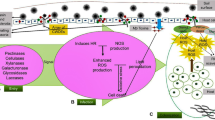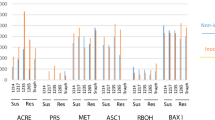Abstract
The major antibiotic metabolites in cotton are condensed proanthocyanidins formed from (+)-catechin and (+)-gallocatechin, and terpenoid aldehydes formed from desoxyhemigossypol. These metabolites occur in specific cells or tissues of healthy plants, and the terpenoids are formed in different cells from the proanthocyanidins. Concentrations of the metabolites increase under the stress of disease or pest invasion. The structure, quantity, and localization of constitutive and infection-induced host metabolites, and the speed of their induced biosynthesis, are discussed in relation to the resistance of tissues and varieties to diseases and pests. Finally, the genetic control of secondary metabolites in cotton is reviewed and discussed in relation to breeding for disease and pest control.
Similar content being viewed by others
References
Bate-Smith, E. C. 1975. Phytochemistry of proanthocyanidins. Phytochem. 14: 1107–1113.
Batson, W. E., Jr., L. S. Bird, W. J. Tolmsoff, and C. M. Cater. 1970. Accumulation of gossypol and gossypol-like pigments associated with defruited cotton plants. Phytopathology 60: 913–914.
Bell, A. A. 1967. Formation of gossypol in infected or chemically irritated tissues of Gossypium species. Phytopathology 57: 759–764.
Bell, A. A. 1969. Phytoalexin production and verticillium wilt resistance in cotton. Phytopathology 59: 1119–1127.
Bell, A. A. 1973. Nature of disease resistance. In: Verticillium Wilt of Cotton. Proc. Work Conf., Aug. 30–Sept. 1, 1971, College Station, Texas. U. S. D. A. Publ. ARS-S-19. p. 47–62.
Bell, A. A. 1974. Biochemical bases of resistance of plants to pathogens. In: Biological Control of Plant Insects and Diseases, F. G. Maxwell and F. A. Harris, eds. The University Press of Mississippi, Jackson, p. 403–461.
Bell, A. A., and C. R. Howell. 1971. Comparative physiology of Verticillium albo-atrum isolates. II. Induction of phytoalexins in cotton. Proc. Beltwide Cotton Prod. Res. Conf., Jan. 12–13, Atlanta, GA. p. 84–85.
Bell, A. A., and J. T. Presley. 1969. Temperature effects upon resistance and phytoalexin synthesis in cotton inoculated with Verticillium albo-atrum. Phytopathology 59: 1141–1146.
Bell, A. A., and J. T. Presley. 1969. Heat-inhibited or heat-killed conidia of Verticillium albo-atrum induce disease resistance and phytoalexin synthesis in cotton. Phytopathology 59: 1147–1151.
Bell, A. A., and R. D. Stipanovic. 1972. Chemistry and nature of fungitoxic compounds in diseased cotton. Proc. Beltwide Cotton Prod. Res. Conf., Jan. 10–12, Memphis, TN. p. 87–88.
Bell, A. A., and R. D. Stipanovic. 1977. The chemical composition, biological activity, and genetics of pigment glands in cotton. Proc. Beltwide Cotton Prod. Res. Conf., Jan. 10–12, Atlanta, GA. p. 244–258.
Bell, A. A., R. D. Stipanovic, C. R. Howell, and P. A. Fryxell. 1975. Antimicrobial terpenoids of Gossypium: Hemigossypol, 6-methoxyhemigossypol, and 6-deoxyhemi-gossypol. Phytochem. 14: 225–231.
Bendz, G., and J. Santesson eds.. 1973. Chemistry in Botanical Classification. Nobel Symposia: Medicine and Natural Science. Academic Press, New York. 320 p.
Boatner, C. H. 1948. Pigments of cottonseed. In: Cottonseed and Cottonseed Products, A. E. Bailey, ed. Interscience Publ. Inc., New York, p. 213–363.
Booth, J. A. 1969. Gossypium hirsutum tolerance to Verticillium albo-atrum infection. I. Amino acid exudation from aseptic roots of tolerant and susceptible cotton. Phytopathology 59: 43–46.
Booth, J. A. 1974. Effect of cotton root exudate constituents on growth and pectolytic enzyme production by Verticillium albo-atrum. Canadian J. Bot. 52: 2219–2224.
Bugbee, W. M. 1970. Vascular response of cotton to infection by Fusarium oxysporum f. sp. vasinfectum. Phytopathology 60: 121–123.
Carter, W. W. 1974. Histological responses of resistant and susceptile Gossypium arboreum to Rotylenchulus reniformis. J. Nematology 6: 138.
Cason, E. T., Jr., P. E. Richardson, L. A. Brinkerhoff, and R. K. Gholson. Histopathology of immune and susceptible cotton cultivars inoculated with Xanthomonas malvacearum. Phytopathology 67: 195–198.
Cauquil, J. (1973). Cotton Boll Rot. English Translation by M. D. Saidi and L. Paul. U.S. Dept. of Commerce, Springfield, VA. 143 p.
Cook, O. F. 1906. Weevil-resisting adaptations of the cotton plant. U.S. Dept. of Agric. Bur. Plant Ind. Bull. No. 88. 81 p.
Gaibullaev, I. K., M. K. Avazkhodzhaev, and A. E. Egamberdiev. 1975. Reaction of chemomutants of cotton to infection by the pathogen of Verticillium wilt. English translation of Genetika 11: 34–36.
Garber, R. H., and B. R. Houston. 1966. Penetration and development of Verticillium albo-atrum in the cotton plant. Phytopathology 56: 1121–1126.
Haslam, E. 1975. Natural proanthocyanidins. In: The Flavanoids, J. O. Harborne, T. J. Mabry, and H. Mabry, eds. Chapman and Hall, London, p. 505–559.
Hopper, D. G., R. J. Venere, L. A. Brinkerhoff, and R. K. Gholson. 1975. Necrosis induction in cotton. Phytopathology 65: 206–213.
Howell, C. R., A. A. Bell, and R. D. Stipanovic. 1976. Effect of aging on flavanoid content and resistance of cotton leaves to Verticillium wilt. Physiol. Plant Pathol. 8: 181–188.
Howell, C. R., R. D. Stipanovic, and A. A. Bell. 1974. Cotton leaf flavanoids as a factor in resistance of cotton to Verticillium wilt. Proc. Beltwide Cotton Prod. Res. Conf., Jan. 7–9, Dallas, TX. p. 30.
Hunter, R. E. 1972. Relationship of plant constituents to seedling diseases. Proc. Beltwide Cotton Prod. Res. Conf., Jan. 10–12, Memphis, TN. p. 86–87.
Hunter, R. E. 1974. Inactivation of pectic enzymes by polyphenols in cotton seedlings of different ages infected with Rhizoctoniasolani. Physiol. Plant Path. 4: 151–159.
Hunter, R. E., J. M. Halloin, J. A. Veech, and W. W. Carter. 1975. Terpenoid aldehydes produced by hypocotyls of cotton seedlings in response to infection by Rhizoctonia solani. Proc. Beltwide Cotton Prod. Res. Conf., Jan. 6–8, New Orleans, LA. p. 23.
Ingham, J. L., and J. B. Harborne. 1976. Phytoalexin induction as a new dynamic approach to the study of systemic relationships among higher plants. Nature 260: 241–243.
Keen, N. T., M. Long, and D. C. Erwin. 1972. Possible involvement of a pathogen-produced protein-lipopolysaccharide complex in Verticillium wilt of cotton. Physiol. Plant Path. 2: 317–331.
Mace, M. E. 1978. Contributions of tyloses and terpenoid aldehyde phytoalexins to verticillium wilt resistance in cotton. Physiol. Plant Path. 12: 1–11.
Mace, M. E., A. A. Bell, and C. H. Beckman. 1976. Histochemistry and identification of disease-induced terpenoid aldehydes in verticillium-wilt-resistant and -susceptible cottons. Canadian J. Bot. 54: 2095–2099.
Mace, M. E., A. A. Bell, and R. D. Stipanovic. 1974. Histochemistry and isolation of gossypol and related terpenoids in roots of cotton seedlings. Phytopathology 64: 1297–1302.
Mace, M. E., and C. R. Howell. 1974. Histochemistry and identification of condensed tannin precursors in roots of cotton sedlings. Canadian J. Bot. 52: 2423–2426.
McClure, M. A., and J. Robertson. 1973. Infection of cotton seedlings by Meloidogyne incognita and a method of producing uniformly infected root segments. Nematologica 19: 428–434.
Minton, N. A. 1962. Factors influencing resistance forcotton to root-knot nematodes (Meloidogyne spp.). Phytopathology 52: 272–279.
Mueller, W. C., and C. H. Beckman. 1976. Ultrastructure and development of phenolic-storing cells in cotton roots. Canadian J. Bot. 54: 2074–2082.
Mussell, H. W. 1973. Endopolygalacturonase: Evidence for involvement in verticillium wilt of cotton. Phytopathology 63: 62–70.
Novacky, A. 1972. Influence of Xanthomonas malvacearum infection on cotton pigment glands. Plant Disease Reptr. 56: 765–767.
Raj, S. A. 1974. Changes in gossypol content of cotton plants susceptible and resistant to Fusarium wilt. Annamalai Univ. Agr. Res. Ann. 4/5: 198–200.
Sadykov, A. A., L. V. Metlitskii, A. K. Karimdzhanov, A. I. Ismailov, R. A. Mukhamedova, M. K. Avazhodahaev, and F. G. Kamaev. Isohemigossypol the phytoalexin in the cotton plant. Dokl. Biochem. (English Translation of Dokl. Akad. Nauk SSSR Ser Biochim) 218: 506–509.
Singh, D., L. A. Brinkerhoff, and G. Guinn. 1971. Effect of alanine on development of verticillium wilt in cotton cultivars with different levels of resistance. Phytopathology 61: 881–882.
Singh, I. D., and J. B. Weaver, Jr. 1972. Effect of gossypol on the incidence of boll rot and agronomic characters of cotton. Cotton Growing Rev. 49: 242–249.
Snow, J. P., and M. G. Sachdev. (1977). Varietal reactions to Diplodia gossypina. Proc. Beltwide Cotton Prod. Res. Conf., Jan. 10–12, Atlanta, GA. p. 25–27.
Stipanovic, R. D., A. A. Bell, and C. R. Howell. 1975. Naphthofuran precursors of sesquiterpenoid aldehydes in diseased Gossypium. Phytochem. 14: 1809–1811.
Stipanovic, R. D., A. A. Bell, and M. J. Lukefahr. 1977. Natural insecticides from cotton (Gossypium). In: Chemical Basis for Host Plant Resistance to Pests. Amer. Chem. Soc. Symposium Series. 62: 197–214.
Stipanovic, R. D., A. A. Bell, M. E. Mace, and C. R. Howell. 1975. Antimicrobial terpenoids of Gossypium: 6-methoxv-gossypol and 6,6′-dimethoxygossypol. Phytochem. 14: 1077–1081.
Stoessl, A., J. B. Stothers, and E. W. B. Ward. 1976. Sesquiterpenoid stress compounds of the Solanaceae. Phytochem. 15: 855–872.
Strand, L. L., and H. Mussell. 1975. Solubilization of peroxidase activity from cotton cell walls by endopolygalacturonases. Phytopathology 65: 830–831.
Swain, T. 1977. Secondary compounds as protective agents. Ann. Rev. Plant Physiol. 28: 479–501.
Veech, J. A. 1976. Localization of peroxidase in Rhizoctonia solani-infected cotton seedlings. Phytopathology 66: 1072–1076.
Veech, J. A. 1978. An apparent relationship between methoxy-substituted terpenoid aldehydes and the resistance of cotton to Meloidogyne incognita. Nematologica 24: 81–87.
Veech, J. A., and M. A. McClure. 1977. Terpenoid aldehydes in cotton roots susceptible and resistant to the root-knot nematode, Meloidogyne incognita. J. Nematology 9: 225–229.
Veech, J. A., R. D. Stipanovic, and A. A. Bell. 1976. Peroxidative conversion of hemigossypol to gossypol. A revised structure for isohemigossypol. J. C. S. Chem. Comm., p. 144–145.
Wang, S. C., and J. A. Pinckard. 1972. Some biochemical factors associated with the infection of cotton fruit by Diplodia gossypina. Phytopathology 62: 460–465.
Wang, S. C., and J. A. Pinckard. 1973. Cotton boll cuticle, a potential factor in boll rot resistance. Phytopathology 63: 315–319.
Wilhelm, S., J. E. Sagen, and H. Tietz. 1974. Resistance to verticillium wilt in cotton: sources, techniques of identification, inheritance trends, and the resistance potential of multiline cultivars. Phytopathology 64: 924–931.
Zaki, A.I., N.T. Keen, and D.C. Erwin. 1972. Implication of vergosin and hemigossypol in the resistance of cotton to Verticillium albo-atrum. Phytopathology 62: 1402–1406.
Author information
Authors and Affiliations
Rights and permissions
About this article
Cite this article
Bell, A.A., Stipanovic, R.D. Biochemistry of disease and pest resistance in cotton. Mycopathologia 65, 91–106 (1978). https://doi.org/10.1007/BF00447180
Issue Date:
DOI: https://doi.org/10.1007/BF00447180




